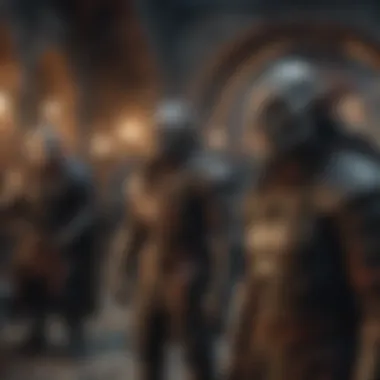Understanding Dungeons & Dragons Character Dynamics


Intro
Dungeons & Dragons, often shortened to D&D, is not just a game; it is an intricate tapestry of characters woven into epic tales of adventure, camaraderie, and conflict. Each character created embodies unique abilities, backgrounds, and motivations that engage players in rich storytelling episodes. The diverse world of D&D offers a buffet of choices, from mystical wizards to formidable warriors, making it a fertile ground for creativity.
Within this article, we will unravel the many layers that make up D&D characters, from their inception to their evolution during gameplay. Players often find themselves immersed in the lives of their characters, developing them through trials and quests, which ultimately leads to an enriching narrative experience.
What will you discover? A detailed exploration of character classes and races—each pivotal to how the game unfolds. Also, we’ll delve into how crucial player decisions shape character arcs and growth throughout the campaign, leaving a lasting impact on both the player and the narrative. Join us as we embark on this adventure of understanding character intricacies in the world of Dungeons & Dragons.
The Role of Characters in Dungeons & Dragons
Characters are the heartbeat of Dungeons & Dragons; they represent players' choices and bring the fantasy world to life. Every character, from the towering half-orc barbarian to the sly halfling rogue, adds their unique flavor to the adventure. Understanding the role of characters isn’t just about stat sheets and dice rolls; it’s about creating a shared narrative that players can engage with. Each character embodies a part of the story, making them integral to both gameplay and the evolving narrative.
In D&D, characters serve multiple key functions:
- Representation of Players: Characters are more than just avatars; they are extensions of the players themselves, allowing them to explore facets of personality that might be dormant in daily life.
- Drivers of Plot: Through their actions and decisions, characters shape the story's trajectory. They respond to the world around them, propel the plot forward, and often discover their arcs through conflict and resolution.
- Social Interaction: The dynamics within a party mirror real-life friendships and rivalries. Characters provide opportunities for roleplaying and emotional depth, fostering connections among players.
- Game Mechanics: Each character is tied into the mechanics of the game—skills, abilities, and proficiencies all affect how they interact with the world and the challenges they face.
The nuances of character roles allow for rich gameplay experiences. Players navigate puzzles, social situations, and combat scenarios with their character's unique strengths and weaknesses. This interplay between mechanics and narrative adds layers to the game, making it not merely about survival but also about storytelling and growth.
"The beauty of D&D lies not just in the fantasy, but in how characters transform the shared journey."
This integration of character roles into gameplay promotes strategic thinking and cooperative storytelling, making each session both a game and an act of creativity. To fully appreciate D&D, players must understand how characters function within these dual spheres of narrative and mechanics.
Defining Character Roles
When we dive into the specifics of character roles in Dungeons & Dragons, it is essential to classify them into primary functions. This understanding helps players maximize both their enjoyment and potential during campaigns. Generally, character roles can be categorized as follows:
- The Frontline Fighters: Characters like Fighters and Barbarians are usually found in the thick of combat, absorbing damage and protecting their allies.
- The Spellcasters: Wizards and Clerics wield spells with great power, supporting their comrades with healing or damage spells while controlling the battlefield.
- The Stealthy Strikers: Rogues excel in maneuvering through shadows and delivering lethal strikes. They often scout ahead and handle delicate circumstances.
- The Support Characters: Bards and Druids, among others, provide healing and buffs, ensuring the party stays in peak condition.
Understanding these roles assists players in creating balanced parties and can lead to smoother, more enjoyable gameplay. Each class and race brings distinct attributes to the table, allowing for a versatile party geared for various challenges.
Narrative and Gameplay Integration
In Dungeons & Dragons, narrative and gameplay are inseparable. They feed into each other, creating an experience that transcends mere play. How players navigate character abilities is intricately entwined with the unfolding story.
- Character Backstories: The history individuals give to their characters often influences choices in-game. A sorceress, haunted by her past, might act differently than a carefree bard. These backstories can introduce personal quests that intertwine with the main plot.
- Decision-Making in Narrative Context: Characters often face moral dilemmas that test their values and motivations. The decisions made in these moments can lead to dramatic storytelling, seasoned by the tension between player intentions and character integrity.
- Interactive Worldbuilding: As players introduce their own rich character backgrounds, the Dungeon Master (DM) can incorporate these elements into the world, creating a living narrative where players' choices lead to real consequences.
Through these integrations, D&D becomes not just a series of encounters but a collaborative narrative, weaving players' contributions into a rich tapestry of adventure. Ultimately, it encourages creativity, not just in character design, but in how stories unfold, making each campaign unique.
Character Creation Process
Character creation stands as a cornerstone in Dungeons & Dragons gameplay, shaping not just the individual adventurer but also the entire party dynamics. When players draft their characters, they don’t just fill out a character sheet; they weave the fabric of their story, melding personal goals and broader campaign arcs. Each choice has a ripple effect, influencing gameplay mechanics, character interactions, and narrative possibilities.
In this section, we'll delve into the nuances of character creation, examining the essential elements that elevate a character from mere statistics to a vital part of a shared storytelling experience.
Understanding the Basics
Getting a grip on the foundational aspects of character creation is crucial. It sets the groundwork for every decision that follows. During this phase, players are introduced to concepts like ability scores, background, race, and class. These elements do more than just determine strengths and weaknesses: they shape how a character fits into the narrative.
Characters in D&D are like puzzles. Each piece has its place, and together they form a cohesive picture. Understanding where to start helps players not only appreciate their character's role but also navigate the intricate web of interactions with others. This step is akin to laying the foundation of a house; without solid ground, everything that follows may crumble.
Choosing a Race
Choosing a character's race is one of the first big decisions a player faces. Each race offers unique traits and abilities that can significantly impact gameplay. Here’s a closer look at some popular races and what they bring to the table.
Human
Humans are often considered the most versatile race in D&D, given their ability to adapt and thrive in various situations. The key characteristic is their "bonus feat," which gives them an edge in skill and versatility. This adaptability makes Humans a popular choice for players looking to experiment with different class mechanics and character builds.
One unique feature of Humans is their ability to be anything from a charismatic bard to a fearsome warrior. Their only disadvantages may come from lacking the racial bonuses that other races provide, but their sheer flexibility compensates for that.
Elf
Elves are known for their grace, agility, and keen senses. A standout aspect of Elves is their innate proficiency in perception and dexterity-based skills. This makes them excellent archers or stealthy rogues—roles that often require finesse and quick thinking.
Elves bring a deep cultural lore that enhances character backgrounds. However, their long lifespan can create challenges in roleplay; they may experience a disconnect with shorter-lived races, which could lead to misunderstandings or tension during campaigns.
Dwarf
Dwarves are sturdy, resilient beings, renowned for their ability to withstand blows and their unmatched skill in crafting. One key characteristic is their high constitution, which gives them an upper hand in combat scenarios.
The Dwarven commitment to tradition and culture adds depth to roleplaying opportunities. While they shine in defense and melee scenarios, their slower movement can be a hindrance in certain fast-paced situations.


Dragonborn
A proud and majestic race, Dragonborn are half-dragon and half-human creatures. Their defining feature is their breath weapon, which allows them to unleash powerful elemental attacks. This characteristic not only adds to their combat prowess but also engages players in unique roleplaying opportunities revolving around their draconic ancestry.
However, they might struggle with social dynamics in campaigns focused on stealth or subterfuge, as their size can make them less than subtle in certain situations.
Tiefling
Tieflings are characterized by their fiendish bloodlines and striking appearance. A noticeable aspect of Tieflings is their innate spellcasting abilities, especially through the Warlock class. This feature allows them to engage in magical tactics early on, giving them an edge in certain encounters.
While their dark heritage provides intriguing story elements, it can also lead to societal prejudices. This tension can result in compelling story arcs but might create barriers in forming alliances with other characters.
Selecting a Class
Following the race, players must select a class that aligns with their character's skills and personality. Each class offers distinct abilities and playstyles, shaping combat roles and party synergy.
Fighter
Fighters excel in combat versatility. Their defining aspect is the ability to use a wide range of weapons and armor effectively. They are adaptable and can fill various roles, from front-line melee attackers to tactical ranged combatants.
One unique feature here is their access to fighting styles, allowing players to customize their combat approach. While Fighters can be a jack of all trades, they risk becoming somewhat predictable in their tactics if not carefully evolved over time.
Mage
Mages harness raw magical power in ways that can shift the landscape of encounters dramatically. The main appeal of being a Mage lies in versatility; they can manipulate elements, alter reality, or conjure creatures. However, this comes at a price; Mages are often physically weaker and may rely heavily on their party for protection.
Mages require careful planning and resource management, making their gameplay rewarding yet complex. Navigating spell selection efficiently can lead to broad advantages in and out of combat.
Rogue
Rogues thrive on cunning and agility. Their key characteristics include natural stealth, dexterous movements, and the ability to deal massive damage when ambush tactics are employed. This class is perfect for players who delight in playing strategically and outsmarting foes.
One unique aspect of Rogues is their ability to open locked doors and disable traps, making them invaluable in dungeon crawling. However, they rely on subterfuge, which can create tension in party dynamics if not balanced properly with other character types.
Cleric
Clerics are the backbone of any adventuring party, combining healing abilities with combat prowess. Their defining aspect is divine magic, which allows them to heal allies, cleanse ailments, and smite foes with holy energy.
One unique feature of Clerics is their domain selection, enabling players to focus on different aspects of their divine patron. While they may lack the offensive capability of pure fighters, their support role can be pivotal in the success of the party.
Bard
Bards are the ultimate support characters whose main appeal lies in their ability to inspire, heal, and manipulate. They shine through charisma and a blend of magic and martial skills. The key aspect is their spells, which often empower allies or debilitate enemies.
One unique feature is the "Bardic Inspiration," allowing Bards to bolster their party's performance significantly. However, since they often balance multiple roles, they may find themselves stretched thin in tight combat scenarios.
Character Backgrounds
The final step in character creation involves selecting a background, which provides depth and color to the character’s personal history. Backgrounds enrich the character with a story rooted in a broader societal context.
Choosing a Background
Choosing a background is more than just a formality; it informs motivations and relationships. Each background offers skills, equipment, and narratives, adding a rich layer of complexity.
Backgrounds also provoke thought about the character's past, creating hooks for potential roleplay opportunities.
Cultural Influences
Cultural influences can dramatically shape the character's upbringing, beliefs, and interactions. If a character hails from a realm known for fierce warriors, it may frame their approach to problem-solving and alliances.
An understanding of cultural influences allows for nuanced interactions and richer narratives within the campaign. Characters may face preconceptions or advantages based on cultural backgrounds, complicating relationships and storytelling.
Socioeconomic Factors
Socioeconomic factors speak volumes about a character's past and motivations. Did they grow up in privilege, or did they claw their way out of the gutter? These backgrounds dictate a character's worldview and how they interact with the party.
Understanding socioeconomic influences sparks discussions about morality, ethics, and personal goals throughout the campaign, ultimately enriching the roleplay experience.
"Character creation in D&D isn’t just about rolling dice; it’s about creating a living story you can share with others."
Character Mechanics


Character mechanics form the structured backbone of any Dungeons & Dragons campaign. While the narrative and role play are undoubtedly significant, understanding the intricate mechanics that govern the gameplay is equally essential for characters to thrive. From how abilities shape what characters can do in the game to their health in desperate situations, these mechanics add dimension and realism to an otherwise fantastical experience.
Ability Scores and Skills
In D&D, ability scores serve as the foundation alongside skills that dictate a character's potential in various areas. Each character possesses six primary ability scores: Strength, Dexterity, Constitution, Intelligence, Wisdom, and Charisma. The scores directly influence not just how strong a character is physically but also their aptitude for magical and social interactions.
- Strength governs a character's physical power, important for melee combatants.
- Dexterity affects agility and reflexes, key for characters like Rogues or archers.
- Constitution relates to a character's health and endurance, making it essential for all.
- Intelligence relates to knowledge and spellcasting for Wizards, while Wisdom serves Clerics and Rangers as an insight into the world.
- Charisma is vital for characters relying on social skills, like Bards and Sorcerers.
The choice of abilities relies heavily on the character's class and playstyle, which can make or break the party's effectiveness in a campaign. Characters can also improve their performance by mastering certain skills. Skills are specific abilities tied to these scores—think Stealth using Dexterity or Persuasion using Charisma. This interplay creates a complex tapestry of possibilities, allowing each player to tailor their approach uniquely.
Proficiencies and Equipment
Once abilities and skills are defined, proficiency takes center stage. This determines what a character is especially adept in, whether it’s wielding a sword, casting an arcane spell, or standing their ground in a negotiation.
Different classes offer a range of proficiencies, and they significantly influence a character's effectiveness. For instance:
- Martial classes may have proficiency with all types of weapons and armor.
- Spellcasters, on the other hand, gain proficiency with a selection of spells that can be cast in combat or utility scenarios.
Arming characters effectively means choosing the right equipment. From weapons that suit the character's fighting style to armor that offers protection without hindering mobility, every gear choice counts.
"A chain mail may take the brunt of the blow, but a fine rapier in the hands of a skilled Rogue is a game-changer."
Equipment also adds layers to character mechanics, allowing players to strategize how they approach conflicts. Carefully selecting equipment that pairs well with a character’s proficiencies maximizes their utility and enhances the overall experience.
Health Points and Combat Mechanics
The combat mechanics in Dungeons & Dragons are crucial for defining encounters in an adventure. Health points, or HP, measure a character's resilience, and once depleted, it leads to unconsciousness or even death. Understanding HP is vital for both players and Dungeon Masters (DMs) alike, as it paves the way for strategic planning in fights.
Combat in D&D operates on a turn-based system where initiative rolls determine the order of actions. A deeper understanding can enable characters to maximize their turns by choosing the right actions, whether it's attacking, casting spells, or healing teammates. Key components of combat mechanics include:
- Actions: Characters can choose to attack, cast a spell, or perform other actions based on class abilities.
- Bonus Actions: Some abilities allow for an action to be performed in addition to standard actions.
- Reactions: These can be used outside of a character's turn, adding unpredictability to combat.
By considering health points and combat mechanics deeply, players not only elevate their characters' effectiveness in battle but also enhance the overall storytelling experience. Building well-rounded characters means understanding their strengths and weaknesses in combat just as much as their role-playing potential.
Strategies for Character Development
Character development in Dungeons & Dragons is not merely about the stats on a character sheet. It encompasses how players engage with their characters and how these personae evolve through experiences in the campaign. A well-developed character can add layers of intrigue and excitement to gameplay, enriching both individual play and group dynamics. This section explores various strategies that can elevate character portrayal and growth.
Roleplaying Tactics
Roleplaying is the lifeblood of D&D. It’s where the imagination takes center stage, and characters come alive. To effectively roleplay, one must tap into the essence of their character—understanding not just their abilities but their emotions, motivations, and flaws. Here are a few tactics to elevate your roleplaying:
- Character Voice: Adopt a unique voice or speech pattern for your character. This could range from a subtle accent to dramatic vocal shifts or even particular phrases they repeatedly use.
- Decision-Making: Always think about what your character would realistically do in various situations. Are they brave, cautious, cynical, or kind? These traits should guide their choices.
- Backstory Utilization: Integrate elements from your character’s background into your actions or dialogue. Let their past influence their relationships and decisions during quests.
- Emotional Depth: Don’t shy away from expressing your character’s emotions during gameplay. Happiness, anger, fear, or sadness can create impactful moments that resonate with others.
“A character who feels is a character who becomes memorable.”
Implementing these tactics helps build rapport with fellow players and creates a more immersive experience. The key is to remain genuine in your roleplaying, balancing character integrity with the flow of the game.
Character Growth Over Campaigns
Growth is a fundamental aspect of what makes D&D captivating. Through adventures, characters face challenges that allow them to evolve, learn from mistakes, and sometimes change fundamentally. Here are some considerations for fostering character growth:
- Challenge Your Character: Put the character in difficult situations that test their morals or skills. Such trials can reveal strengths or weaknesses that might not be apparent at first.
- Relationships Matter: Building bonds with other party members can lead to meaningful character development. These dynamics can introduce conflict, support, or mentorship, shaping how a character views the world.
- Embrace the Narrative: Align character decisions and growth with the broader storytelling arc. This allows for a more seamless integration of personal and campaign narratives and amplifies the emotional stakes involved.
- Evaluate and Reflect: Engagement shouldn’t end when the session does. Take time to reflect on how encounters affect your character. What did they learn? How do they feel about their journey?
- For example, a rogue might face a scenario that requires them to choose between stealing for personal gain or helping a down-and-out NPC.
- A warrior might grow to learn the value of compassion through interaction with a cleric, changing their approach to conflicts.
By intentionally crafting characters that can grow alongside the story, players enrich not only their own experience but also that of their fellow adventurers. The depth of character development contributes significantly to the overall impact of any D&D campaign, turning what could be a simple game into an unforgettable narrative experience.
Interpersonal Dynamics in Character Interaction
In the sprawling universe of Dungeons & Dragons, characters aren’t just soulless tokens meant for combat and loot. Instead, they breathe life into the campaigns, forging connections, alliances, and sometimes even rivalries. Understanding the interpersonal dynamics in character interaction is crucial for enhancing gameplay and narrative depth. Without this understanding, groups can find themselves grappling with awkward encounters and missed opportunities for engagement.
Party Composition and Synergy
The mix of characters within a party is fundamental to the overall experience. Different races and classes bring unique abilities, perspectives, and stories, creating a vivid tapestry of interaction. Think of it as a recipe: too much of one ingredient can skew the flavor of the meal.
A well-rounded party typically features a blend of different classes and skills. For instance, having a tank like a Fighter alongside a support character such as a Cleric ensures that damage can be absorbed while the party maintains health. This balance not only helps in combat situations but promotes roleplaying opportunities.


Moreover, synergy among characters strengthens their bonds. Characters with complementary skills, like a Rogue’s stealth abilities paired with a Wizard's knowledge of traps, can create dynamic gameplay.
Here are some key benefits of thoughtful party composition:
- Diverse Skill Sets: Each character can contribute to various situations, whether negotiating with NPCs or overcoming obstacles.
- Enhanced Storytelling: Diverse backgrounds lead to richer interactions and conflict opportunities, making the narrative more immersive.
- Team Morale: Characters who riff off each other create a more enjoyable experience, both in game and for players' emotional investment.
Conflict Resolution within Parties
Conflicts within parties are often unavoidable. When personal goals clash or misunderstandings occur, tensions can arise. However, if handled effectively, these conflicts offer a chance for character growth and story advancement. Players face choices that may alter alliances or reshape their characters' ethics.
Using in-game dialogue, players can navigate disagreements, facilitating deeper relationships among characters. Emphasizing empathy, active listening, and problem-solving transforms disputes into enriching narrative elements rather than dead ends.
Consider these potential tactics for conflict resolution:
- Open Dialogue: Encourage discussions in-character to surface perspectives and motivations.
- Mediator Role: Designate a player for moments when disputes turn heated, helping realign the group’s focus.
- Shared Goals: Remind characters and players of their common objectives, fostering unity even through trials.
"Conflict is merely the consequence of differing goals, but it’s through resolution that real character development emerges."
Character Backstories and Relationships
Each character comes with a past that shapes their present and influences future choices. Elaborating on backstories offers invaluable context for interactions. Players should consider how their character's history impacts relationships within the party, whether it fosters camaraderie or ignites tension.
For example, a character haunted by a dark past may find it hard to trust others. This can manifest in interactions, making for complex narratives.
Creating connections strengthens the story further:
- Alliances from the Past: A character may recognize an old enemy within the party, setting the stage for growth and tension.
- Cross-Character Backstories: Encourage players to weave their backstories together. This can lead to intricate personal quests.
- Romantic Entaglements: Romance can add depth; however, it should be approached delicately to avoid overshadowing the main plot.
In essence, the relationships between characters fuel both combat and narrative. Exploring these interpersonal dynamics can be the difference between a mundane session and a truly memorable campaign.
Challenges and Limitations in Character Play
Navigating the world of Dungeons & Dragons isn’t merely about skills or lore; it hinges on recognizing the challenges and limitations tied to character play. Acknowledging these obstacles not only enhances gameplay but also deepens the experience for everyone at the table. Characters, while brimming with potential, often face power dynamics and personal failures that can affect the party’s journey. These elements can lead to richer interactions and more profound storytelling.
Balancing Character Power Dynamics
Every character brings unique abilities to the table, yet this variety can lead to imbalances. Consider, for instance, a party consisting of a powerful wizard alongside a lowly thief. The wizard can hurl fireballs while the thief might struggle just to break a lock. When one character consistently overshadows others, it can breed resentment or disinterest among players. To avoid this, it’s crucial to find a sweet spot where every player feels their character contributes meaningfully to the group.
Strategies for Balance
- Fostering Collaboration: Encourage players to think about how their characters can work together. A good mix of skills can elevate gameplay, making each session feel cohesive.
- Setting Limits: The Dungeon Master can set certain constraints, ensuring that no single character's abilities dominate the game’s narrative.
- Emphasizing Roleplay: Often, non-combat moments allow characters to shine. Showcase each character's strengths outside of battle, like persuasive speech or tactical thinking.
Balancing power dynamics can enrich the campaign, enabling everyone to shine in their own right.
Handling Character Failures
Character failures are not only natural; they are a valuable aspect of storytelling in D&D. When a character falters—be it through a failed quest or an unfortunate roll—it opens the door to character development and growth. This is a chance for rich narratives to surface.
"Failure is not the opposite of success; it's part of success."
In the context of D&D, this rings especially true. Embracing failure can result in unforeseen turns in the story, where redemption or unexpected alliances are born.
Approaches to Manage Failures
- Providing Support: Other players may rally around a character that has faced failure. This can build team cohesion and lead to story arcs driven by loyalty and friendship.
- Character Growth: Failure can highlight flaws, leading to engaging backstories or character arcs that evolve over time. For instance, a cowardly character may find bravery when it’s required, crafting a compelling narrative.
- Incorporating Roleplay: Encourage players to explore how failures affect their character's psyche. This can make for some truly gripping roleplay.
Ultimately, confronting challenges and accepting limitations enriches the D&D experience. Recognizing the power dynamics and using failures as narrative devices cultivates a storytelling landscape where players can thrive, leading to unforgettable adventures.
The Evolution of & Characters
Tracing the evolution of Dungeons & Dragons characters unveils not just a timeline but a reflection of shifting cultural narratives and gaming paradigms. Over the years, D&D has morphed significantly, adapting to the voices of its players as well as the societal changes surrounding the game. Understanding this evolution is critical, as it highlights how character dynamics continue to shape storytelling and gameplay experiences.
The development of D&D characters isn't just about statistical growth or level advancement; it’s about the cultural context that influences who these characters are, what they represent, and how they function in the complex web of the game. From their inception in the 1970s to the intricate characters of today, each phase marks a statement about personal identity, power dynamics, and the intersections of fantasy with reality.
Historical Perspectives
The roots of Dungeons & Dragons lie in early tabletop games and the literary works that inspired them. The first edition introduced an array of character classes, each with a well-defined role in the adventure. This set the stage for not only gameplay mechanics but also the narrative roles these characters could embody.
- The Founding Era (1974-1980): The original players, wielding minimal class options, commonly played straightforward warriors or wizards, lacking the depth in backstories that later editions would embrace. Characters were often archetypes, effortlessly falling into the roles they represented.
- The Second Edition (1989): This period saw the introduction of more complex rules and backgrounds, including more topical issues like moral alignment. Players began to craft characters who not only fought together but also had personal motivations and histories.
- The Third Edition and Beyond (2000-Present): Weighty improvements brought in a multitude of new classes, races, and customization options. Character creation grew into a veritable art form, with an extensive range of choices that allowed for nuanced roleplaying. Players also began to explore the moral ambiguities and contrast of their characters, diving deeper into what each avatar meant in the narrative picture.
Emerging Trends
As the game marched toward modernity, new trends began influencing character development, further reflecting societal shifts and gamer preferences. These trends demonstrate a growing demand for representation, inclusivity, and a departure from stereotypes.
- Diversity in Playable Races and Classes: Characters are not confined to traditional races and classes anymore; there are now options that represent a range of ethnic backgrounds and abilities. This reflects not just a broadened audience but a richer gaming experience.
- Narrative Complexity: Players are increasingly interested in moral dilemmas and the exploration of the shades of gray in character decisions. Character flaws, consequences of actions, and deeper personalities are now integrated into crafting character arcs, leading to richer, more emotionally charged stories.
- Community Involvement and Homebrew Content: Players now contribute actively to the evolution of character options. Homebrew races, classes, and entire campaign settings developed by the community have injected fresh perspectives and innovative mechanics into the game, empowering players to shape the narrative landscape.
The evolution of D&D characters underscores much more than gameplay changes; it exemplifies how a community adapts to its aesthetic preferences and cultural shifts. Each character created today holds a piece of history, resonating with the broader experience of storytelling, community interaction, and game engagement. As the game continues to evolve, looking back at its past and anticipating its potential futures will undoubtedly enrich the journey for both players and storytellers.



